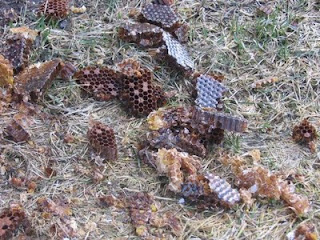






After Hilary opened the hives and smoked the bees slightly, Paul used a leaf blower to brush off the bees remaining on the frames removed from teh hive. This was fairly gentle and a lot faster than by hand. The bees were later given sugar water, not a fair trade, but it pacified them somewhat.
Golden rod and wild asters are abundant but not many other flowers are available now. Lidino clover planted this spring did not do well, the area is probably too wet.
We have not weighed the extracted honey yet, we also saved several frames for comb honey, actually our favorite for eating.
Tomorrow Hilary and I will test composites for
Salmonella,
Listeria, total coliform,
E. coli
, staphylococci, streptococci and clostridium. We do this periotically when we remove honey, with satisfactory results.

 Paul and Dorothy Hess died after a car accident this month. Words are inadequate to express the sadness we feel. They were wonderful giving people, generous with their time and knowledge and had so much yet left to share with us all. October 17, 2011
Paul and Dorothy Hess died after a car accident this month. Words are inadequate to express the sadness we feel. They were wonderful giving people, generous with their time and knowledge and had so much yet left to share with us all. October 17, 2011




































